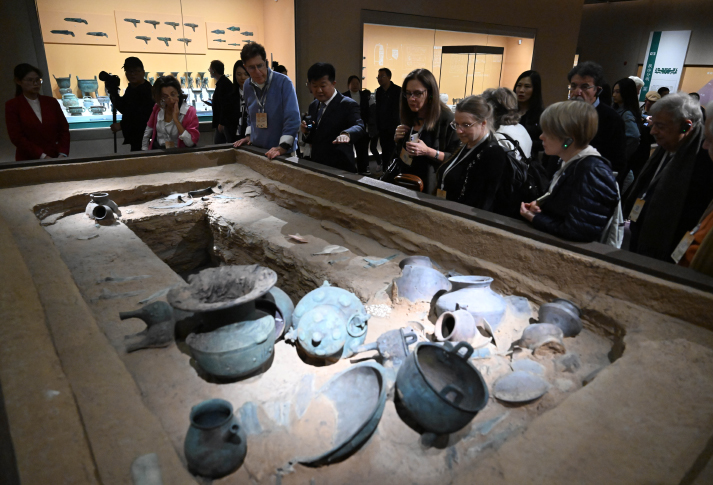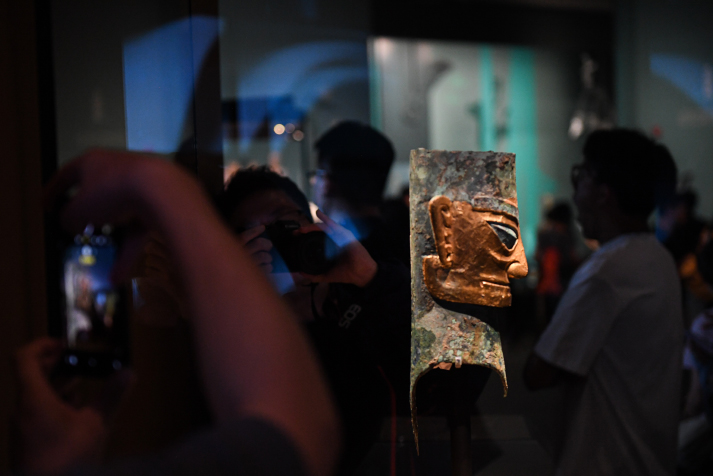| China |
| Archaeological discoveries shed light on China's early dynasties | |
|
|
 Relics on display at the Yinxu Museum in Anyang, Henan Province on November 5, 2024 (XINHUA)
Emperor Taizong of the Tang Dynasty (618-907) famously told his ministers that "Using a bronze mirror, a person can adjust his attire; using history as a mirror, one can understand the rise and fall of a country." More than 1,000 years later, the wisdom of Taizong, one of the greatest emperors of China who led the country into prosperity, continues to resonate in modern China, where the study of history drives advancements in archaeology and vice versa. Every year, two key events mark the progress of archaeology in China. The first is the announcement of the Top 10 Archaeological Discoveries of the year, selected by a committee of top-notch scholars from archaeological institutes and universities, and released in March. This list celebrates the most significant discoveries from the previous year, highlighting those with crucial academic, historical and social value. The second event is the announcement of the Top 10 Domestic Archaeological News list and Top 10 International Archaeological News list by China Media Group, which garners widespread attention and showcases the most exciting archaeological updates. The year 2024's Top 10 Domestic Archaeological News included the remarkable discovery of the tombs belonging to the family of Noble Consort Dong, who was one of the consorts of Emperor Xuanzong, Taizong's great-grandson. These tombs were unearthed in Xi'an, now the capital of Shaanxi Province, which served as a capital city for 13 dynasties throughout Chinese history. A researcher from the Shaanxi Academy of Archaeology told newspaper Shaanxi Daily, "This new discovery provides critical clues for research into the politics, culture and burial customs of the time. The epitaphs unearthed from Dong's family cemetery may reveal political mysteries of the Tang Dynasty and shed light on the decisions of Emperor Xuanzong." Timeless treasures Another discovery from Shaanxi Province made the list of Top 10 Archaeological Discoveries of 2023. Unearthed in Qingjian County, north Shaanxi, the Zhaigou site reveals clues about the territory of the Shang Dynasty (1600-1046 B.C.), the earliest known dynasty in Chinese history to have a written record, known as oracle bone inscriptions. "The findings of Zhaigou site were proved to belong to the lord of one of the local regimes under the supervision of the central government of the Shang, which was located in Henan Province," Zhong Jianrong, head of the Shaanxi Academy of Archaeology, told Beijing Review. "Ever since the discovery of Yinxu in Henan Province, the archaeology field has been curious about the territory, administrative system and the geological and political influence of the Shang. I think the Zhaigou site has provided us with some precious clues about the cohesiveness of our nation thousands of years ago." Located in Anyang, Henan Province, Yinxu is the ruins of the capital city Yin of the Shang Dynasty. It was listed as a World Cultural Heritage site by UNESCO in 2006. Another old and prestigious archaeological site that have yielded new findings is the Sanxingdui site in Sichuan Province. Dating back to 3000-1200 B.C., the site enjoys worldwide fame for offering a glimpse into advanced bronze manufacturing technology and the ancient Shu Kingdom, a country that once flourished in present-day Sichuan Province. "We have unearthed jade workshops, building foundations and large-scale water networks on the northern bank of the original Sanxingdui site, gaining insight into the layout and functional zoning of the ancient Sanxingdui city. The unearthed cultural relics reveal the close interaction between the Sanxingdui people and people from central and northwest China, as well as the middle reaches of the Yangtze River, which is an important indication of the diverse and integrated nature of Chinese civilization," Ran Honglin, head of the Sanxingdui Research Institute of Archaeology, an organization under Sichuan Provincial Institute of Cultural Relics and Archaeology, said at a meeting on the latest developments in archaeology, hosted by the National Cultural Heritage Administration (NCHA) on December 26, 2024. Some archaeological findings tell stories of unity among different regions and ethnic groups within China. "Our latest results indicate that during the Shang and Zhou (1046-256 B.C.) dynasties, the materials and casting technologies of bronze objects in central areas such as Yinxu and border areas developed synchronously, suggesting frequent economic and cultural exchanges," Chen Jianli, a professor with the School of Archaeology and Museology of Peking University, said at a forum about recent archaeological accomplishments in border areas, held in Beijing on December 27, 2024. In addition to uncovering the origins of the Chinese civilization itself, archaeology also creates connections between China and other nations. "During the Tang Dynasty, the current Xinjiang Uygur Autonomous Region was an important part of the ancient Silk Road, which served as the main channel for cultural exchange between China and Europe. The excavation of the Nestorian monastery site on the west side of Turpan City in Xinjiang, which thrived during the Tang and Song (960-1279) dynasties as a religious melting pot, has produced research results that reflect the inclusive policies on border governance and religious exchange adopted by the central government in ancient China, as well as the interaction and integration of various ethnic groups," Guo Wu, a researcher at the Institute of Archaeology of the Chinese Academy of Social Sciences, said at the forum about recent archaeological accomplishments in border areas on December 27, 2024.  A bronze mask from the Sanxingdui archaeological site, on display at an exhibition in Beijing, on December 24, 2024 (XINHUA)
Collective efforts A package of all-round supportive policies regarding land use, funding, tax reductions and streamlined administrative processes issued by the government has contributed to the thriving of archaeology in China since the 2010s. For example, the newly published rule on the protection of cultural relics in 2024 requires archaeological exploration be carried out before land that might contain relics is sold for the renovation and development of old urban areas, placing archaeology before land transfer. Zhongcun community in Jinzhong, Shanxi Province, has benefited from this new rule. Land that was to be sold within the community was assessed by the Shanxi Academy of Archaeology, revealing an advanced cemetery dating back to the early Shang Dynasty. "The new rule transforms cultural relic protection from the passive protection in the past to active protection now. After we implemented the rules in Henan Province, the number of archaeological excavation projects increased from over 140 per year to around 300 during 2023," Ren Wei, head of the Henan Provincial Administration of Cultural Heritage, said at a press conference in December 2023. "I would say that the last 10 years has been the golden age for archaeology, with supportive policies, nationwide public attention, advanced equipment, systematic training and talented professionals in place to foster the development of the field. With more advantageous rules and people's growing interest in archaeology, I'm confident about more breakthroughs in this field in the future," Zhong said. "For the next step, we aim to improve archaeology-related administrative processes and mechanisms, strengthen the safety management of archaeological sites; establish more archaeological site parks; and make more efforts to protect, promote, and utilize the achievements we made," Qiao Yunfei, deputy head of the NCHA, said at a conference on urban archaeological development, held on December 4, 2024, in Chengdu in southwest China. Copyedited by G.P. Wilson Comments to zhangyage@cicgamericas.com |
|
||||||||||||||||||||||||||||
|